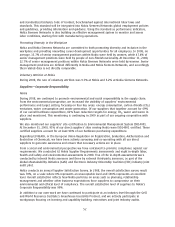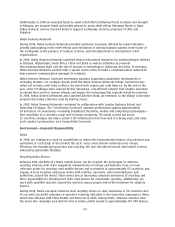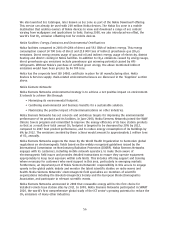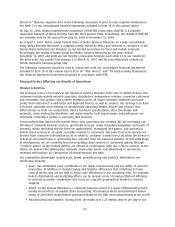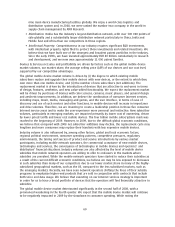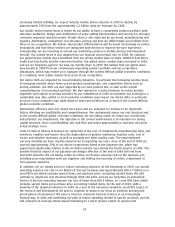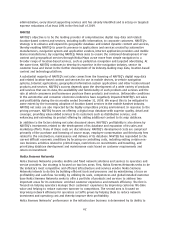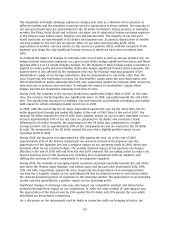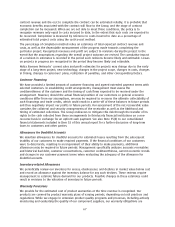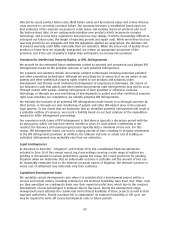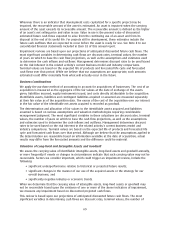Nokia 2008 Annual Report Download - page 63
Download and view the complete annual report
Please find page 63 of the 2008 Nokia annual report below. You can navigate through the pages in the report by either clicking on the pages listed below, or by using the keyword search tool below to find specific information within the annual report.administrative, every shared supporting services unit has already identified and is acting on targeted
expense reductions of at least 10% in the first half of 2009.
NAVTEQ
NAVTEQ’s objective is to be the leading provider of comprehensive digital map data and related
locationbased content and services, including traffic information, to corporate customers. NAVTEQ’s
strategy is to enhance and expand its geographic database and related dynamic content and services,
thereby enabling NAVTEQ to grow its presence in applications and services created by automotive
manufacturers, navigation system and application vendors, Internet application providers and mobile
device manufacturers. By acquiring NAVTEQ, Nokia aims to ensure the continued development of our
context and geographical services through Nokia Maps as we move from simple navigation to a
broader range of locationbased services, such as pedestrian navigation and targeted advertising. At
the same time, NAVTEQ continues to develop its expertise in the navigation industry, service its
customer base and invest in the further development of its industryleading map data, locationbased
content and technology platform.
A substantial majority of NAVTEQ’s net sales comes from the licensing of NAVTEQ’s digital map data
and related locationbased content and services for use in mobile devices, invehicle navigation
systems, Internet applications, geographical information system applications and other locationbased
products and services. NAVTEQ’s success depends upon the development of a wide variety of products
and services that use its data, the availability and functionality of such products and services and the
rate at which consumers and businesses purchase these products and services. Unfavorable conditions
in the automotive and consumer electronics industries have negatively impacted NAVTEQ’s net sales
and profitability during the six months ended December 31, 2008. We expect this to be mitigated to
some extent by the increasing adoption of location based services in the mobile handset industry.
NAVTEQ net sales are also impacted by the highly competitive pricing environment. In response to the
pricing pressure, NAVTEQ focuses on offering a digital map database with superior quality, detail and
coverage; providing valueadded services to its customers such as distribution services; and
enhancing and extending its product offering by adding additional content to its map database.
In addition to the factors driving net sales discussed above, NAVTEQ’s profitability is also driven by
NAVTEQ’s investments related to the development of its database and expansion of its sales and
marketing efforts. Many of these costs are discretionary. NAVTEQ’s development costs are comprised
primarily of the purchase and licensing of source maps, employee compensation and thirdparty fees
related to the construction, maintenance and delivery of its database. NAVTEQ has responded to the
current difficult economic conditions by focusing on controlling costs, including exiting certain non
core business activities related to printed maps, restrictions on recruitments and travelling, and
prioritizing database development and maintenance costs based on customer requirements and
return on investment.
Nokia Siemens Networks
Nokia Siemens Networks provides mobile and fixed network solutions and services to operators and
service providers. Our strategy is focused on two key areas. First, Nokia Siemens Networks seeks to be
the industry’s most competitive and efficient infrastructure and services vendor. Nokia Siemens
Networks intends to do this by building efficient tools and processes and by maintaining a focus on
profitability and cash flow. Secondly, by utilizing its scale, competences and global installed customer
base Nokia Siemens Networks seeks to offer a portfolio of products and services to address two
important areas for its customers: enriched customer experience and network efficiency. The first is
focused on helping operators manage their customers’ experience by improving customer lifetime
value and helping to reduce customer turnover to competitors. The second area is focused on
improving network efficiency for operators as traffic grows by helping them to reduce network
investment and operating cost and thereby improve their profitability.
Nokia Siemens Networks’ performance in the infrastructure business is determined by its ability to
62


